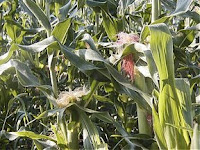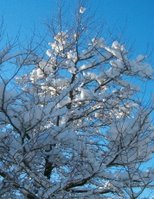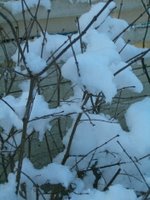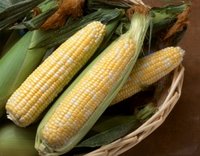
Organic Additives to Ensure a Record Harvest
The snows have melted, a current of warm air has invaded British Columbia, and if I look closely at our garden, I can see Sara’s spring bulbs starting to come up through the fertile soil.
The crocuses and the daffodils are the first to break through; can hyacinths and tulips be far behind? Sara is worried that another cold spell will harm her little ones, but the weekend forecast is for warm temperatures and sunshine.
Sunshine is a rare commodity on the West Coast of Canada in the winter, even though it is an essential element in photosynthesis. Lately we’ve had many snowfalls, windstorms, and torrential rainfalls, with very little of the golden yellow elixir that gives life to plants.
Eloise writes that Hamilton, New Zealand is experiencing daytime highs in the mid-twenties Celsius (ah, the joys of summer) range, and even at night it rarely goes below 18º or 19º C.
“The rainfall slowed down, but most days it’s still overcast Down Under. Although the sun has shown its face once in a while, to remind us of what summer should be like.”
“John is worrying that the corn isn’t getting enough growth spurting sunshine, but our sweet corn crop is of a decent height, the stalks are almost up to my shoulders.”
“We are determined to stick to 100% organic ingredients in our watering-nutrient mix. The market is very good for organic product these days, and ethically we can’t cheat and add a synthetic additive, here and there. A neighbour of ours does exactly that, and we always chide him for it.”
“Lately, our attention has been focused on three purely organic supplements: Emerald Shaman, Colossal Bud Blast, and Grandma Enggy’s Seaweed Extract.”
“Emerald Shaman uses all natural fermented ingredients to enhance not only the growth of your plants, but also their resistance to pests and diseases. It is a time honoured tradition in the Orient to use fermented plant food to increase yield and vigour.”
“In addition to water-soluble organic Nitrogen, it has natural source Phosphates and Potassium, both easily able to dissolve in water. It is applied at the rate of one full tablespoon per 90 Litres of water, so we scoop five and a half tablespoons into our 500 L Watering Tank.”
“As soon as we started using this stuff, we started to see the results. Our vegetables seemed to be extra energized with their stalks and leaves more robust than usual.”
“Emerald Shaman can be used directly for your root watering, as well as a foliar spray. When using it as a spray, be sure to use it very early in the morning or definitely after sunset. The bioactives in this product are adversely effected by direct sunshine in droplets of water. The droplets act as tiny prisms, magnifying the effects of the sun and may destroy the active ingredients, as well as burn your leaves as a result.”
“Advanced Nutrients recommends using several different foliar sprays, alternating them by applying on consecutive days. In addition to Emerald Shaman, another one of their great products that was initially formulated as a foliar spray is Colossal Bud Blast.”
“These sprays are to be diluted in pH balanced water, with no other ingredients mixed into the solution. Scorpion Juice is another organic foliar spray that John uses all the time on our sweet corn and vegetables. It imparts induced systemic resistance to many pests and pathogens.”
“Colossal Bud Blast can be used both during the vegetative stage as well as the bloom period. It helps increase the girth and growth of your flowers and fruit by helping your plants absorb organic nutrients and hormones better.”
“This magic product contains biostimulants from a natural source, as well as naturally occurring chelators and surfactants, such as humic acid. As you know, humic acid takes its name from humus, the rich, black, organic layer of earth that universally grows the best vegetables and flowers.”
“Although it was formulated as a foliar spray, it can also be applied to the root system with great benefit. “
“Over 50% of Colossal Bud Blast is made up of a base-tea concentrate, derived from high phosphate bat guano, krill extract, seaweed meal, and alfalfa meal—all time-proven ingredients in organic horticulture.”
“The rest is made up of complex amino acids as well as the aforementioned humic acid. This intricately engineered mix stimulates our vegetables into producing the best possible flowers and fruit, in terms of quality, size, and weight.”
“You should see our tomatoes! They’re already the size of our best store-bought organic produce, and we still have weeks to go before harvest. Our neighbours come and visit and never leave without jotting down the url of the Advanced Nutrients website, they are so impressed!”
“The third miracle product that I’m very excited about using is Grandma Enggy’s Seaweed Extract. It almost acts as a multi-vitamin for our sweet corn and other vegetables. We’re surrounded by the Pacific Ocean, so it only stands to reason that we should derive one of our favourite plant nutrients from the sea itself.”
“The hydrolysed kelp in Seaweed Extract not only contains the most important B Vitamins (thiamine, riboflavin, B12), but also Vitamin C (ascorbic acid), Vitamin E (tocopherol), two Vitamin A precursors, and Vitamin K. It also has folic acid, panthothenic acid, and folinic acid.”
“The Advanced Nutrients technical guys explained to John that the Vitamin E found in seaweed is very useful in horticulture, because it has a complete set of isomers, similar to the form of the Vitamin found in seed oil, such as linseed oil and wheat germ.”
“As an extra bonus, Grandma Enggy’s Seaweed Extract features natural antibiotics that help all our plants become resistant to aphids, mites, mildew, and other forms of parasitic fungi.”
“I’ve already sung the praises of Grandma Enggy’s other great products, notably Humic Acid and Fulvic Acid, so I won’t continue to bend your cyber ear. Suffice it to say that these supplements, coupled with our base 100% organic nutrients of Iguana Juice, Grow and Bloom, are well on their way of ensuring a bumper crop this year of sweet corn, tomatoes, cucumbers, hot peppers, two kinds of onions, carrots, and potatoes.”
“John and I are forever grateful to you and Sara for helping to turn us into expert gardeners through our use of these Advanced Nutrients products.”
The snows have melted, a current of warm air has invaded British Columbia, and if I look closely at our garden, I can see Sara’s spring bulbs starting to come up through the fertile soil.
The crocuses and the daffodils are the first to break through; can hyacinths and tulips be far behind? Sara is worried that another cold spell will harm her little ones, but the weekend forecast is for warm temperatures and sunshine.
Sunshine is a rare commodity on the West Coast of Canada in the winter, even though it is an essential element in photosynthesis. Lately we’ve had many snowfalls, windstorms, and torrential rainfalls, with very little of the golden yellow elixir that gives life to plants.
Eloise writes that Hamilton, New Zealand is experiencing daytime highs in the mid-twenties Celsius (ah, the joys of summer) range, and even at night it rarely goes below 18º or 19º C.
“The rainfall slowed down, but most days it’s still overcast Down Under. Although the sun has shown its face once in a while, to remind us of what summer should be like.”
“John is worrying that the corn isn’t getting enough growth spurting sunshine, but our sweet corn crop is of a decent height, the stalks are almost up to my shoulders.”
“We are determined to stick to 100% organic ingredients in our watering-nutrient mix. The market is very good for organic product these days, and ethically we can’t cheat and add a synthetic additive, here and there. A neighbour of ours does exactly that, and we always chide him for it.”
“Lately, our attention has been focused on three purely organic supplements: Emerald Shaman, Colossal Bud Blast, and Grandma Enggy’s Seaweed Extract.”
“Emerald Shaman uses all natural fermented ingredients to enhance not only the growth of your plants, but also their resistance to pests and diseases. It is a time honoured tradition in the Orient to use fermented plant food to increase yield and vigour.”
“In addition to water-soluble organic Nitrogen, it has natural source Phosphates and Potassium, both easily able to dissolve in water. It is applied at the rate of one full tablespoon per 90 Litres of water, so we scoop five and a half tablespoons into our 500 L Watering Tank.”
“As soon as we started using this stuff, we started to see the results. Our vegetables seemed to be extra energized with their stalks and leaves more robust than usual.”
“Emerald Shaman can be used directly for your root watering, as well as a foliar spray. When using it as a spray, be sure to use it very early in the morning or definitely after sunset. The bioactives in this product are adversely effected by direct sunshine in droplets of water. The droplets act as tiny prisms, magnifying the effects of the sun and may destroy the active ingredients, as well as burn your leaves as a result.”
“Advanced Nutrients recommends using several different foliar sprays, alternating them by applying on consecutive days. In addition to Emerald Shaman, another one of their great products that was initially formulated as a foliar spray is Colossal Bud Blast.”
“These sprays are to be diluted in pH balanced water, with no other ingredients mixed into the solution. Scorpion Juice is another organic foliar spray that John uses all the time on our sweet corn and vegetables. It imparts induced systemic resistance to many pests and pathogens.”
“Colossal Bud Blast can be used both during the vegetative stage as well as the bloom period. It helps increase the girth and growth of your flowers and fruit by helping your plants absorb organic nutrients and hormones better.”
“This magic product contains biostimulants from a natural source, as well as naturally occurring chelators and surfactants, such as humic acid. As you know, humic acid takes its name from humus, the rich, black, organic layer of earth that universally grows the best vegetables and flowers.”
“Although it was formulated as a foliar spray, it can also be applied to the root system with great benefit. “
“Over 50% of Colossal Bud Blast is made up of a base-tea concentrate, derived from high phosphate bat guano, krill extract, seaweed meal, and alfalfa meal—all time-proven ingredients in organic horticulture.”
“The rest is made up of complex amino acids as well as the aforementioned humic acid. This intricately engineered mix stimulates our vegetables into producing the best possible flowers and fruit, in terms of quality, size, and weight.”
“You should see our tomatoes! They’re already the size of our best store-bought organic produce, and we still have weeks to go before harvest. Our neighbours come and visit and never leave without jotting down the url of the Advanced Nutrients website, they are so impressed!”
“The third miracle product that I’m very excited about using is Grandma Enggy’s Seaweed Extract. It almost acts as a multi-vitamin for our sweet corn and other vegetables. We’re surrounded by the Pacific Ocean, so it only stands to reason that we should derive one of our favourite plant nutrients from the sea itself.”
“The hydrolysed kelp in Seaweed Extract not only contains the most important B Vitamins (thiamine, riboflavin, B12), but also Vitamin C (ascorbic acid), Vitamin E (tocopherol), two Vitamin A precursors, and Vitamin K. It also has folic acid, panthothenic acid, and folinic acid.”
“The Advanced Nutrients technical guys explained to John that the Vitamin E found in seaweed is very useful in horticulture, because it has a complete set of isomers, similar to the form of the Vitamin found in seed oil, such as linseed oil and wheat germ.”
“As an extra bonus, Grandma Enggy’s Seaweed Extract features natural antibiotics that help all our plants become resistant to aphids, mites, mildew, and other forms of parasitic fungi.”
“I’ve already sung the praises of Grandma Enggy’s other great products, notably Humic Acid and Fulvic Acid, so I won’t continue to bend your cyber ear. Suffice it to say that these supplements, coupled with our base 100% organic nutrients of Iguana Juice, Grow and Bloom, are well on their way of ensuring a bumper crop this year of sweet corn, tomatoes, cucumbers, hot peppers, two kinds of onions, carrots, and potatoes.”
“John and I are forever grateful to you and Sara for helping to turn us into expert gardeners through our use of these Advanced Nutrients products.”
posted by Tim at
10:01 PM
|
0 comments
![]()









